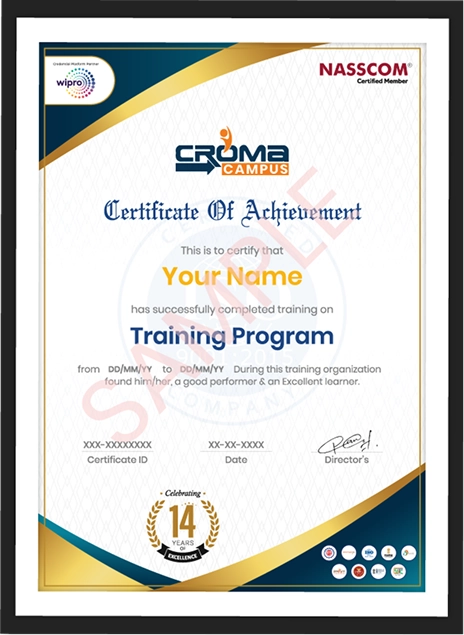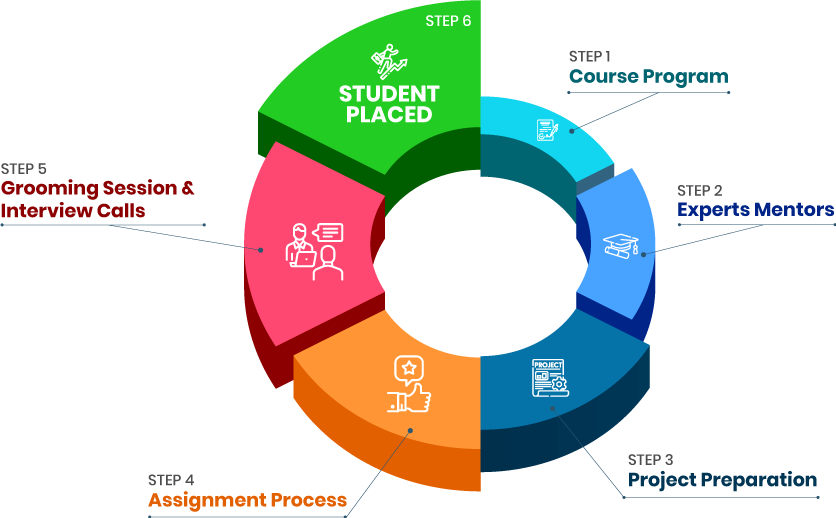- 2 Live Project
- Self-Paced/ Classroom
- Certification Pass Guaranteed
Course Offered By
The course will enable to master various Java components. You can also learn designing and create robust web applications. You also learn to design single page applications or multiple page applications as per the need.
You can learn to design powerful and superior apps by utilizing MEAN stack to the maximum potential.
You can also develop deep understanding of many web development concepts such as JQUERY, AJAX, events, plug-ins, forums, Google APIs and other same concepts.
The full stack placement course in Gurgaon helps to create documents by using MongoDB and other query reports.
You would also learn to consume web series and know the development of front end and back end.
You will learn to develop high-technology apps in less time in less money by using Type Script or Java Script techniques.
The Full stack developer training in Gurgaon helps to develop application parts such as controllers, directives and services.
You will develop deep understanding of full stack development technologies including MongoDB, Express, Angular, Node.js, CSS, HTML, React JS, and more.
You must have information about Java components and how to build and design powerful web apps from scratch. You must know how to design single page apps or multiple page apps according to specifications.
You must know how to create robust apps by using full stack development technologies.
You can develop deep understanding of various web development concepts such as AJAX, JQUERY, plug-ins, events, forms, Google APIs, and other concepts.
You must know how to build documents by using MongoDB and work on query reports.
You must know how to consume web series, front-end development and back-end development.
You should to develop high-end app in less time in a reasonable cost by using Type Script or Java Script techniques.
You must have a clear idea of how to develop application parts such as directives, controllers, or services.
we train you to get hired.
we train you to get hired.
By registering here, I agree to Croma Campus Terms & Conditions and Privacy Policy
Arithmetic
Relational
Logical
Assignment
Membership
Identity
Define PHP
Installation of PHP
PHP delimiters
Variable initialization with PHP
PHP Data types
PHP Constants
PHP Operators
If else
If else if else
Nested If
Switch Case
Jump Statements (Break, Continue, Exit)
For loop
While loop
Do While Loop
Nested Loop
Index based arrays
Associative Array
Multi-Dimensional Array
Presenting the user with input
Retrieving form data with $POST$_GET and $_ REQUEST
Preserving Data in Form inputs
Introducing Functions
Define functions
Using parameters
Returning values
Call by Value & Call By reference
Reusing Codes
Array, String, Math, Date functions
Super Global Array Variables
Deleting Cookies
Implementing Query String
Classes, objects and operations
Class attributes
Access Modifier Constructor & Destructor
Inheritance Static method Type
Hinting Object
Cloning Abstract class
Final keyword Inheritance
Introduction
How to load Library
How to override other Libraries
Introduction
Introduction
Introduction
Introduction
Introduction
HTML
CSS
JavaScript
JQuery
HTML 5
Bootstrap 5 (HTML, CSS, and JS Library)
Adobe Photoshop
Web Hosting
PHP Fundamentals
Arrays and Functions in PHP
MySql Database
Object Oriented PHP
File Handling & State Management
Advanced PHP Techniques
Developing A Dynamic Web Application
Framework: Laravel
Framework: CodeIgniter
WordPress development
What is HTML
What is a Web Browser
What can you Do with HTML
HTML Development Environments
Writing Code with a Text Editor
Publishing Documents
Rules of Syntax
Making your Code Readable
Making your Code XHTML Compliant
Building a Document
Using Colors
Adding Color to your Page
Using Headings
Using Paragraphs
Aligning Block-Level Elements
Displaying Preformatted Text
Formatting with Inline Elements
Controlling Fonts
Introducing List Elements
Creating Unordered Lists
Creating Ordered Lists
Nesting Lists
Building a Table
Cell Padding and Cell Spacing
Controlling Table and Cell Width
Aligning a Table on the Page
Aligning Tables and Text
Aligning Table Data
Spanning Columns and Rows
Nesting Tables
Using Tables as a Design Tool
Understanding and Using URLs
Linking to a Web Document
Linking to a Local Document
Linking to Anchors
Opening a New Browser Window
Optimizing Image and File Size
Inserting Inline Images, Image Map, Sprite Image
Aligning and Formatting Images
Using Images to Anchor Links
Creating a Look-and-Feel
Sizing and Scaling Images
Using Transparent Images
Using GIF Animation
Forms and Form Elements
Form Actions, Form Methods, Form Design
Border
border-image
border-radius
Text-shadow
Box-shadow
background-clip
background-size
background-origin
background-image
transition
transition-delay
transition-duration
transition-property
transform
matrix ()
translate (x, y)
scale (x, y)
rotate(angle)
skew (x-angle, y-angle)
transform
transform-style
perspective
transform-origin
@keyframes
animation
animation-direction
animation-duration
animation-name
CSS combinations
Pseudo Elements
Linear Gradients
Radial Gradients
column-count
column-fill
column-gap
column-width
column-rule
column-rule-color
column-rule-style
column-rule-width
resize
box-sizing
outline-offset
Blur
Brightness
Contrast
Grayscale
Hue-rotate
Invert
Opacity
Saturate
Sepia
What is Responsive Web Design
Intro to the Viewport
The Viewport Tag
Media Queries
Fluid Layouts
Tablet Styles
Mobile Styles
Making a Mobile Drop-down Menu
Responsive Images & Poly fills
@font-face
font-family
src
font-stretch
font-style
font-weight
flex-grow
flex-shrink
flex-basis
flex
flex-wrap
flex-direction
flex-flow
justify-content
align-items
order
Syntax
Statements
Comments
Alert
Confirm
Prompt
Arithmetic
Assignment
Comparison
Logical
Relational
Ternary
If else
if...else if...else
nested if
Switch
Loops
While
do...while
for
for...in Statement
Break
Continue
User-defined Functions
Function Syntax
Function with Arguments
Returning Values from Functions
Built-in Functions
Introduction
Mouse
Events
Keyboard Events
Form Events
Document/Window Events
Number
Strings
Math
Arrays
Associative
Array
Array Properties and Methods
Date
Boolean
Reg exp
Prototype, Module pattern
Argument type
Closure
ES 6 Introduction
Let & Const
Arrow Functions
Class and Inheritance
Rest and Map Operators
Export & Import
Modules
Selecting Elements
Manipulating the Page
Traversing the DOM and Chaining
jQuery Utility Methods
Handling Events and Event Delegation
AJAX, JSON, and Deferred
Enhancing with Animation Effects
Grids, Tables with Ajax, Pagination, JQuery UI
jQuery Best Practices
History of JavaScript
What is ES6 (ECMAScript 6/JavaScript 6)
ES6 Module System
A Word on Bable
Block Scope, Let & Const
Template Literals
Arrow Functions
Spread and Rest Operators
Object Literal Improvements
De-structuring
Classes
Inheritance
Static Properties and Methods
Promises
Iterators and Iterables
Generators
Modules
New Features in ES6
JavaScript let
JavaScript let
JavaScript const
JavaScript Arrow Functions
JavaScript Classes
Default parameter values
Array.find()
Array.findIndex()
Exponentiation (**) (ECMA Script 2016)
History of Angular
The leap from AngularJS to Angular
Whats new in Angular 10
Angular 10 vs Angular 9
Desktop Application class User Experience
Productivity and Tooling
Performance
Community
Full-featured Framework
Supported Browsers (Angular 10)
Platform for Targeting Native Mobile not just Web Browsers
Introduction
What is Typescript
Why Typescript
Setup and installation
IDE support
Different typescript versions
Typescripts 3.8 for Angular 10
Scoping using let and const Keywords (ES6)
Template Literals (ES6)
Rest and Spread Parameters (ES6)
De-structuring (ES6)
Introduction to Types
Type inference
Type Annotations
Number
Boolean
String
Array
Tuple
ENUM
Any
Void
Spread and Rest Operators
Object Literal Improvements
De-structuring
Classes
Inheritance
Static Properties and Methods
Promises
Iterators and Iterables
Generators
Modules
New Features in ES6
JavaScript let
JavaScript const
JavaScript Arrow Functions
JavaScript Classes
Default parameter values
Array.find()
Array.findIndex()
Exponentiation (**) (ECMA Script 2016)
Audience
Pre-requisites
About Node
Execute Node
Features
Who use Node
Concepts
Where to use
Where not to use
Text Editor
NodeJs Run Time
Download NodeJs
Installation
Executing
Creating a NodeJs Application
Make a request to NodeJs Server
What is REPL
Starting REPL
REPL Commands
Stopping REPL
Installing Modules using NPM
Global vs Local Installation
Using packages.json
Attributes of packages.json
Uninstalling Module
Updating Module
Searching Module
Create a Module
Using Props
Default Props
State and Props
Validating Props
Set State
Force Update
Find DOM Node
Lifecycle Methods
Simple
Complex
Simple
Child
What is Refs
Using Refs
What is Keys
Using Keys
Install a React Router
Add a Router
Create Components
What is Flux
Flux Elements
Flux Props
Install REDUX
Create Files and Folders
Actions
Reducers
Store
Root Component
Other Components
Install React CSS Transitions Group
Add a CSS File
Appear Animation
Enter and Leave Animations
Connecting Node and MongoDB
Database Creation, Drop
Collection Operations
Documents Operations
Node and MongoDB Application
Introduction, Advantages
Environment Setup
Basic Application
Request
Response
GET
POST
Routing
HTTP Methods
URL Building
Middleware
Templates
Static Files
Form Data
Database
Cookies
Sessions
File Upload
Authentication
REST FUL APIs
Scaffolding
Debugging
Introduction, Advantages
History, Features
No SQL Databases
Advantages over RDBMS
Install MongoDB
MongoDB Shell
MongoDB Data Model
MongoDB Datatypes
Create Database
Drop Database
Create Collection
Drop Collection
Insert Documents
Update Documents
Delete Documents
Query Documents
Limit ()
Sort ()
Skip ()
History of JavaScript
What is ES6 (ECMAScript 6/JavaScript 6)
ES6 Module System
A Word on Bable
Block Scope, Let & Const
Template Literals
Arrow Functions
Spread and Rest Operators
Object Literal Improvements
De-structuring
Classes
Inheritance
Static Properties and Methods
Promises
Iterators and Iterables
Generators
Modules
New Features in ES6
JavaScript let
JavaScript const
JavaScript Arrow Functions
JavaScript Classes
Default parameter values
Array.find()
Array.findIndex()
Exponentiation (**) (ECMA Script 2016)
Audience
Pre-requisites
About React
Features
Advantages
Limitations
Create of Root Folder
Install Global Packages
Add Dependencies and Plugins
Create the Files
Set Compiler, Server and Loaders
html
JSX and Main.js
Running the Server
What is JSX
Using JSX
Nested Elements
Attributes
JavaScript Expressions
Styling
Components
Naming Convention
Stateless
State full
What is State
Props
Using Props
Default Props
State and Props
Validating Props
Set State
Force Update
Find DOM Node
Lifecycle Methods
Simple
Complex
Simple
Child
What is Refs
Using Refs
What are Keys
Using Keys
Install a React Router
Add a Router
Create Components
What is Flux
Flux Elements
Flux Props
Audience
Pre-requisites
About Node
Execute Node
Features
Who use Node
Concepts
Where to use
Where not to use
Text Editor
NodeJs Run Time
Download NodeJs
Installation
Executing
Creating a NodeJs Application
Make a request to NodeJs Server
What is REPL
Starting REPL
REPL Commands
Stopping REPL
Installing Modules using NPM
Global vs Local Installation
Using packages.json
Attributes of packages.json
Uninstalling Module
Updating Module
Searching Module
Create a Module
Using Props
Default Props
State and Props
Validating Props
Set State
Force Update
Find DOM Node
Lifecycle Methods
Simple
Complex
Simple
Child
What is Refs
Using Refs
What is Keys
Using Keys
Install a React Router
Add a Router
Create Components
What is Flux
Flux Elements
Flux Props
Install REDUX
Create Files and Folders
Actions
Reducers
Store
Root Component
Other Components
Install React CSS Transitions Group
Add a CSS File
Appear Animation
Enter and Leave Animations
Connecting Node and MongoDB
Database Creation, Drop
Collection Operations
Documents Operations
Node and MongoDB Application
Introduction, Advantages
Environment Setup
Basic Application
Request
Response
GET
POST
Routing
HTTP Methods
URL Building
Middleware
Using Props
Default Props
State and Props
Validating Props
Set State
Force Update
Find DOM Node
Lifecycle Methods
Simple
Complex
Simple
Child
What is Refs
Using Refs
What is Keys
Using Keys
Install a React Router
Add a Router
Create Components
What is Flux
Flux Elements
Flux Props
Introduction, Advantages
History, Features
No SQL Databases
Advantages over RDBMS
Install MongoDB
MongoDB Shell
MongoDB Data Model
MongoDB Datatypes
Create Database
Drop Database
Create Collection
Drop Collection
Insert Documents
Update Documents
Delete Documents
Query Documents
Limit ()
Sort ()
Skip ()
we train you to get hired.
Phone (For Voice Call):
+91-971 152 6942WhatsApp (For Call & Chat):
+91-971 152 6942Stories
success
inspiration
career upgrade
career upgrade
career upgrade
career upgrade
You will get certificate after
completion of program
You will get certificate after
completion of program
You will get certificate after
completion of program
in Collaboration with

Empowering Learning Through Real Experiences and Innovation
we train you to get hired.
Phone (For Voice Call):
+91-971 152 6942WhatsApp (For Call & Chat):
+91-971 152 6942Get a peek through the entire curriculum designed that ensures Placement Guidance
Course Design By
Course Offered By
Ready to streamline Your Process? Submit Your batch request today!
Croma campus is one of the best institutes for the training of IT professional jobs. It is one of the most prestigious and certified organizations that has been associated with the top most MNCs. Croma Campus is really famous for its innovative and technical teaching methods. So, if you want to get linked with Full Stack Developer then do a Collab with Croma Campus.
Full Stack Developer is a web developer who works with both the front and back ends of a website or application. There are a lot of works and jobs under Full-Stack Developer. The first thing you need to do is to always keep your profile updated on LinkedIn because they are directly associated with Full-Stack Developer. So, if you get Full Stack Developer Training you can work as a front-end and back-end developer both for websites or applications.
Full Stack is nowadays becoming a very important skill that can lead you to get a good job. To get any web development job you need to get training in Full-Stack Development. There is a list of things after which you can become the best Full Stack Developer that contains in-depth training, many simultaneous exams, live demos, and other industrial projects that can make you a perfect Full-Stack Developer.
Croma Campus India program sizes a powerful training tool that can be applied in classrooms as well as in manufacturing. We offer a wide range of agendas for Live Project Full Stack Developer Training in Gurgaon under the leadership of the best industrial experts. We are always awarded for the past 10 years as the Best Full Stack Developer Training Institute in Gurgaon.
The ways to connect Croma Campus
Phone Number: - +91-120-4155255, +91-9711526942
Email: - info@cromacampus.com
Address: - G-21, Sector-03, Noida (201301)
Highest Salary Offered
Average Salary Hike
Placed in MNC’s
Year’s in Training

fast-tracked into managerial careers.
Get inspired by their progress in the
Career Growth Report.
FOR QUERIES, FEEDBACK OR ASSISTANCE
Best of support with us
For Voice Call
+91-971 152 6942For Whatsapp Call & Chat
+91-9711526942





















